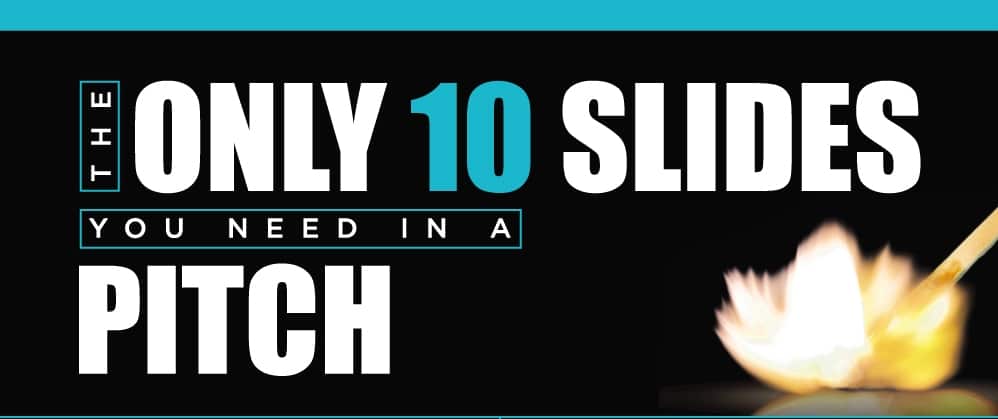A lot of people have heard of Guy Kawasaki and his 10/20/30 rule. I personally think this is overly simplistic, but it is worth thinking about in an effort to make your pitch SIMPLE to understand. Remember, your goal is to get investors wanting to know more. They won’t want to know more if they can’t bring themselves to read 60 slides of dense, meandering prose. So let’s get into it.
Why is keeping your deck simple?
Guy has Ménière’s disease, the symptoms of which include hearing loss, tinnitus (constant ringing sound), and vertigo (Dizziness). Funnily enough this is how most VCs actually feel when being pitched constantly. It’s pretty ironic.
I have to listen to hundreds of entrepreneurs pitch their companies. Most of these pitches are crap: sixty slides about a “patent pending,” “first mover advantage,” “all we have to do is get 1% of the people in China to buy our product” startup. These pitches are so lousy that I’m losing my hearing, there’s a constant ringing in my ear, and every once in while the world starts spinning.
The 10/20/30 Rule of PowerPoint pitch decks
PowerPoint presentation should have ten slides, last no more than twenty minutes, and contain no font smaller than thirty points.
10 slides
- Apparently mere mortals cannot comprehend more than ten concepts in a meeting—and VCs are very normal.
- If you must use more than ten slides to explain your business, you probably don’t have a business. I disagree, but anyway.
- Problem
- Your solution
- Business model
- Underlying magic/technology

- Marketing and sales
- Competition
- Team
- Projections and milestones
- Status and timeline
- Summary and call to action
20 minutes
- You should give your ten slides in twenty minutes
- You have an hour time slot, but shit happens
- The projector won’t work, people will arrive late, you have the sniffles.
- Best case is you give your pitch in 20 minutes, and you have 40 left for discussion which is the important bit
30 size font
- Old people cant read good – don’t use 10 font
- People can read. You are there to perform and sell not do a book telling
- If the VC figures out your plan to do a book reading, they read ahead, as you can’t talk as fast as they can read (They go deaf)
- Founders use small font as: they don’t know their material well enough; they think that more text is more convincing.
Force yourself to use no font smaller than thirty points. I guarantee it will make your presentations better because it requires you to find the most salient points and to know how to explain them well. If “thirty points,” is too dogmatic, the I offer you an algorithm: find out the age of the oldest person in your audience and divide it by two. That’s your optimal font size.
Context to the 10/20/30 rule
Don’t actually follow what he says! Frequently, teachers will say extreme things as they know the student will only half take the lessons to heart. So they exaggerate so you get more to where you should be.
You also need to understand what the deck is for.
- Demo day. If you are doing a pitch on a demo day, you typically have 4 minutes, not 20 minutes!
- Send before a meet deck. Your deck should be longer as I will explain below
- Meeting deck. You never present to VCs! You have discussions. The only time you will do a presentation is when you are pitching a larger firm and you present to the full partnership. Even then, you will not have 20 minutes of uninterrupted monologue
10 slides
Decks should not be 10 slides. A proper deck should be around 17-22 slides. There is no way to check all the boxes that you need to. Don’t believe me, look at Reid Hoffman’s pitch deck when raising for LinkedIn. Linkedin Pitch Deck to raise $10m Series-B. You aren’t going to say he’s a dumb ass, right? I’ve just never seen a good 10 slide deck… ever!
20 minutes
As I explained above, you never present to investors. Ok, fine, there might be neophyte angels that might ask you to.
30 font
Ok, he’s not totally off the font size here. Bear in mind he’s purposefully coming up with a catchy term of 10/20/30, so take this with a pinch of salt. Life is not clean like that.
Sometimes fonts render differently in PowerPoint (I don’t know why) but for body text, I try to have a minimum of font 24. For footnotes, I get down to 8. For body headers, I am about 32 and 36 depending on what I am doing. Btw, I started a pitch deck company so I know this shizzle.
Pitch deck examples which don’t use 10/20/30 😉
If you want to see 140 funded pitch decks, then check out this: World’s largest collection of pitch decks


